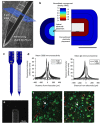State-of-the-art MEMS and microsystem tools for brain research
- PMID: 31057845
- PMCID: PMC6445015
- DOI: 10.1038/micronano.2016.66
State-of-the-art MEMS and microsystem tools for brain research
Abstract
Mapping brain activity has received growing worldwide interest because it is expected to improve disease treatment and allow for the development of important neuromorphic computational methods. MEMS and microsystems are expected to continue to offer new and exciting solutions to meet the need for high-density, high-fidelity neural interfaces. Herein, the state-of-the-art in recording and stimulation tools for brain research is reviewed, and some of the most significant technology trends shaping the field of neurotechnology are discussed.
Keywords: MEMS; brain research; electrophysiology; microelectrodes; neural engineering; neuroscience; optoelectrodes; optogenetics.
Conflict of interest statement
FW is the VP of Product Development of Diagnostic Biochips, Inc., a for-profit manufacturer of neurotechnology. The remaining authors declare no conflicts of interest.
Figures






References
-
- Allen PG, Collins FS. Toward the final frontier: The human brain. Wall Street Journal 2013.
-
- Azevedo FAC, Carvalho LRB, Grinberg LT et al. Equal numbers of neuronal and nonneuronal cells make the human brain an isometrically scaled up primate brain. Journal of Comparitive Neurology 2009; 513: 532–541. - PubMed
-
- Fishell G, Heintz N. The neuron identity problem: Form meets function. Neuron 2013; 80: 602–612. - PubMed
Publication types
Grants and funding
LinkOut - more resources
Full Text Sources
Other Literature Sources
